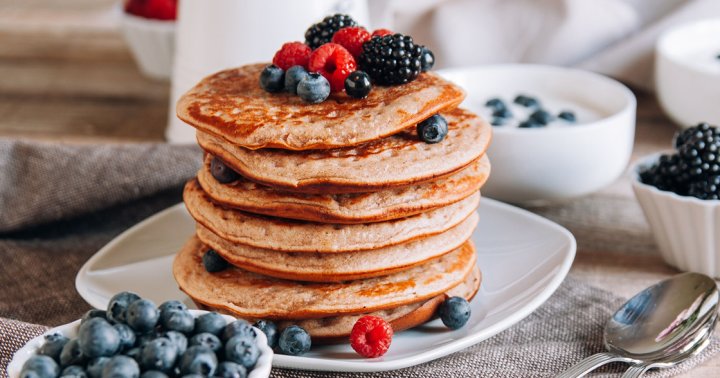This Unique, Underrated Seed Is Rich In Antioxidants + Supports Brain Health
Plus, it's packed with powerhouse nutrients.

At mindbodygreen, we're always keeping our eyes peeled for the latest super-nutritious ingredient to add to our repertoire. Fortunately, we work with so many knowledgeable experts who are always at the cutting edge of innovations and discoveries in the nutrition world, such as Jeffrey Bland, Ph.D., the founder of Big Bold Health who is fondly known as the "Father of Functional Medicine."
As mbg's health director, I work with Bland and his team on a regular basis, and I'm always eager to hear his insights on an array of health and well-being topics. So when I first heard him rave about a new "super ingredient" he's working with, I was immediately intrigued. The star food: Himalayan tartary buckwheat.
What is Himalayan tartary buckwheat?
Himalayan tartary buckwheat (or HTB, for short) is a sibling of the buckwheat plant. Contrary to what the name may imply, this crop is a seed, not a grain—and, interestingly enough, it's closer to the rhubarb and sorrel family of vegetables than wheat. As such, it's gluten-free, rich in phytonutrients, and contains a variety of vitamins and minerals. "It’s high in complete proteins and it's high in prebiotic fiber, for a healthy microbiome," Bland tells mindbodygreen. In fact, it has twice as much protein as quinoa.
Where HTB is particularly unique, however, is its resilience and ability to grow amid challenging circumstances. "Himalayan Tartary buckwheat goes back centuries in the Chinese diet," says Bland. "It’s a plant that survived despite the harsh growing conditions of its Himalayan mountain valleys. It survived by producing a portfolio of unique compounds that became the stress-fighting immune system of the plant itself."
HTB has a slightly bitter taste, but that's a sign of its benefits, according to Bland. "A hearty plant produces the tools it needs to survive in harsh conditions," such as bitterness, he explains. "And those phytonutrients deliver powerful benefit to whoever eats them."
Clearly this species of buckwheat has an impressive nutrient portfolio—which is why Bland calls it a "powerhouse for nutrition." Here are a few highlights of this unique super-plant that really stand out to me:
It has immune-supporting properties.
Among other antioxidants, HTB has high levels of quercetin, a phytonutrient that research suggests has a wide array of benefits—including supporting immune health and managing inflammation.
It may promote brain health.
Another star antioxidant you'll find in HTB: rutin. Studies suggests this phytonutrient may protect against neurodegenerative diseases, by fighting free radicals and oxidative stress. And there's 50 times more rutin in HTB than regular buckwheat.
It's full of important vitamins and minerals.
As mentioned, HTB is packed with all kinds of crucial nutrients. This includes: magnesium; B vitamins, including B1, B2 and B6; and zinc.
The unique plant also contains D-chiro-inositol, a molecule involved in blood sugar regulation and hormone balance in our bodies.
My experience with HTB flour
After hearing Bland speak so highly of Himalayan Tartary Buckwheat and reading some of the research supporting this unique nutrient powerhouse, I was very eager to give it a try. So when Bland's team at Big Bold Health sent a sample of their new Himalayan Tartary Buckwheat Super Nutrition Flour—I couldn't wait to start cooking with it.
This small-batch artisanal flour is milled and packaged in upstate New York, and it's the world's first-ever certified organic, US-grown harvest of Himalayan Tartary Buckwheat. As mentioned, part of the reason this buckwheat is so abundant in nutrients is due to its harsh growing conditions—which is why Big Bold Health strategically worked with a co-op of farmers based in Norther regions, where it gets very cold.
After the two-pound bags of this unique flour arrived at my door—packaged oh-so-nicely, and sealed with a tight weave of red string—I quickly looked into different ways to use this novel ingredient. The Big Bold Health team sent me an array of delicious-sounding recipes, and I opted for buckwheat pancakes (from Mark Hyman, M.D.) as my first trial run. These easy-to-make pancakes were filled with some of my favorite ingredients and spices—plus, I loved topping them with berries and a drizzle of nut butter for extra flavor, texture, and nutrients. I also tried out a recipe for almond & tartary buckwheat muffins, an awesome meal-prep option that left me with nutritious snacks for days.
The verdict: Both of these healthy dishes were very tasty, and I would absolutely make them again. They had a rich, hearty flavor—and were fantastic meals to start the day or get a little boost of nutrition mid-afternoon. As someone who is acutely aware of how certain foods impact my energy levels, focus, and overall sense of well-being—I was very impressed by how satiated I felt for hours after noshing on these recipes, without those nasty feelings of a blood sugar spike or crash.
Unlike some gluten-free flours that get really dense in baking projects, the HTB flour maintained a light, fluffy texture in these classic dishes. Plus, the pancakes in particular had a gorgeous deep maroon hue, that added a bit of visual joy to the whole experience. It's worth noting that both of these recipes use a combination of almond flour and Himalayan tartary buckwheat, to balance out the slight bitterness of the HTB flour.
Curious to try the Himalayan Tartary Buckwheat Super Nutrition Flour yourself? Sign up here to receive a 50% off coupon for the flour + 8 free recipes (including the pancake and muffin recipes I mentioned!).
After giving it a try myself, I can't wait to experiment with all the unique ways I can use this powerhouse ingredient in my own cooking, and make it a more regular part of my well-being routine. Because, as Bland previously shared with mbg: "I’ve come to think of superfoods, as nature’s delivery mechanism for the right balance of macronutrients and a powerhouse blend of micro- and phytonutrients. A true superfood should cover all the bases, and that’s what a plant like Himalayan Tartary buckwheat does."

 ValVades
ValVades 
































